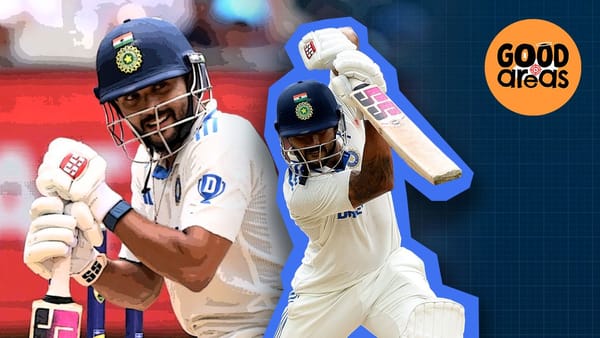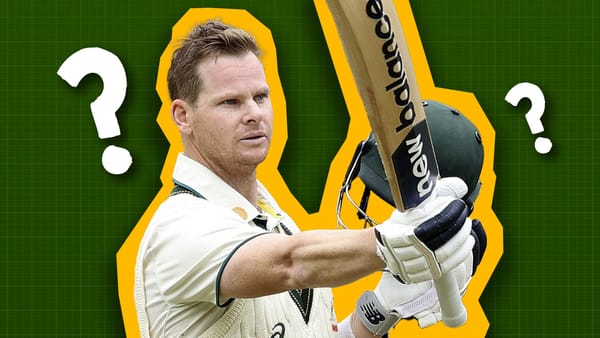The luck and good choices that got New Zealand in the final
The WTC, strikes, Covid and practice Tests.
Yes, I have started a series on the history of New Zealand openers. Perhaps my favourite breed of cricketer.
New Zealand is not supposed to be in the World Test Championship. International cricket is designed to help the bigger teams. Until recently they never had to qualify for anything. And then three took over completely. Look how often the big three teams host major events. They've had all the Men's World cups since 2011, including the next one. The last World T20s, and the next two. And hell, just for fun, the last two Champions trophies, if you consider them major. Let's add this World Test championship to that list as well.
Three teams have over a 100 Tests in the last ten years; you will not be shocked to know who the three teams are. This helps Australia, England and India as they play each other a lot in all those matches. They average 7.6 Tests are year with two of those teams playing. This means that the players from these three countries are playing high-quality opponents in long series a lot. Behind the scenes of the big three, the boards were quite honest. part of the reason for the attempted takeover was to ensure that other teams wouldn't have the money to catch them in player development and analysis.
It's not that smaller nations won't find quality players. But maybe you can develop yours quicker or keep them on the field longer. So that your team will never have the same kinds of low lows.
It's not really a surprise to anyone at this point that cricket is run for the bigger boards. But then comes along the World Test championship. A twice thwarted competition that wasn't really pushed by the major three nations.
And the WTC is a weird thing. You're trying to fit a league into a bunch of pre-existing bilateral agreements. And a sport that wasn't made for a championship. We had one league in Tests; it rained a lot, the Australian players went on strike, and it gave us the ICC.
This WTC has given us something far more strange, a system that doesn't benefit the big three teams. It starts with the points, in this league series are more important than Tests. Every series starts with 120 points if you win every match. In a two-Test series, that's 60 points a win, in a five-Test series that's 24. One-nil is worth more than a two-nil.
England, India and Australia have to win a lot more Tests to get the points. The teams who play the smaller series don't need to win that much. And not only are India, Australia and England the only three teams averaging over 10 Tests a year over the last decade. England played three times as many Tests as Bangladesh in the WTC.
So if you play a two-test series 1-0, you get more points than winning a five-Test series 2-0. And it's not that the idea is terrible; it's that the pre-existing system is. It was a flawed way of making it all work. And having a system like this means that teams will play for wins all the way through series and perhaps end the dead rubber problem. Except there aren't many of those, really as most series are pretty short.
But no matter how hard you try, it's hard to win a series 3-0 or 4-0. The entire history of Tests suggests this. And even New Zealand would know this; I meant they have played five-Test series. Even if their last one was 1971.
And so the teams that play in these series are at a disadvantage in this league. So this is one of the most anti-big three things to come out of the ICC since that phrase was invented.
A follow on from that is the smaller teams players aren't tired from playing so many Tests. Australia and England have already lent pretty heavily into rotation. With India's recent injury history of their bowlers, they might look into a similar thing.
Smaller teams, like New Zealand, don't play many Tests. Kane Williamson has averaged 7.6 a year in his career. That's a leisurely amount of Tests. You can play in the IPL, and all formats of your national teams, and still have loads of energy left. England average 12 Tests a year.
But there are other advantages New Zealand got. They only played 5 series, they played the second-fewest amount of Tests (though they had company there) and Bangladesh basically didn't enter the WTC. So those five series came to 11 matches, five away, six at home. But remember, the number of Tests is less important than the amount of series. And so the fact they played more series at home than away is a tremendous help.
In their five away fixtures, they beat drew with Sri Lanka 1-1 and then lost three straight against the Aussies. That's a 20% win record, where they were 6-0 at home. But they were almost as bad away as they were good at home. And before Covid, they were a ways back on the table.
But something else fell their way. An away series with Bangladesh was cancelled. Had that been a more profitable series with bigger teams, they might have played it. But Bangladesh wasn't bending over backwards to work out how to fit New Zealand in for two Covid Tests.
No one knows how New Zealand would have done there as they haven't played in Bangladesh since 2013. That was a different era for both teams. But they've never lost a Test in Bangladesh, and with how they are playing of late, they'd have hoped for at least a win.
Home teams won 60% of WTC matches, yet Bangladesh didn't win a Test in the league, but they only played seven. New Zealand would have backed themselves for a win, at least. But not playing was easier.
Especially with what happened next. Because of Covid, the league had to go to the 'least bad' option of win percentage over points. So any team with more home games than away was looking ok.
That meant that New Zealand had two home series against West Indies and Pakistan, which consisted of four matches. they cleaned them up 4-0 and slingshot back up the standings. And the good news is they'd already done the hard part, beating India 2-0 at home. Australia, who bowled their front-liners into the ground against India, lost a crucial home series. And England won a Test in India, but then struggled as they rested and rotated so many players it was hard to remember who was on tour before each Test.
There is no doubt the changes in the format and the dual losses to India played into New Zealand's hands. But by no means do the Kiwis deserve the amount of scepticism some fans have paid them.
Others (by others, read some Australian fans) say that New Zealand shouldn't be in the final because they can't beat Australia. Look, I don't know why New Zealand can't beat Australia, but I know they didn't in the 2019 World Cup, and they went within a ricochet of winning the whole thing. In their last two series against the other two highest-ranked teams, they have gone 3-0.
So if some of what I said earlier made it sound like they were the last team standing, that's not true. Even if their qualification for the final was wind-assisted.
And that breeze continued after they qualified.
Because then they had two Tests scheduled in England for the week before the final. Oh, and shall we make this even more kiwi friendly? How about make them non-WTC matches so the consequences are low. Let's add not having to face Buttler, Stokes or Archer either? While allowing them to see exactly who was best suited to conditions, give many players a run, rest guys who had niggles and get used to playing top-quality cricket in England. And, let's throw in some confidence from a win as well.
Oh, and the final will be played in New Zealandish conditions. An advantage for a New Zealand side, even more when an Asian team qualifies beside them.
None of this is what the Big 3 had in mind when they tried to take over the sport. If the WTC was for anything, it was to allow them to host and pick up a new trophy every few years. And now New Zealand spoils their party more than southern England weather.
But, there are many smaller Test teams out there, and none of them were even close to getting here. And while some things out of their control went the way of New Zealand, it's worth looking at a bunch of factors that brought them here.
In 2002 their first class system was terrible. It wasn't professional, it was poorly run, and it was keeping their overall talent pool stagnant. They had always provided top-level players, and those usually ended up in county cricket. Those talented chosen few got better, but the overall standard never improved. You can see that happening as far back as the 1930s. So the players going on strike - as Iain O'Brien put it to me, it's not really a strike if you don't have a job - changed the direction of New Zealand cricket.
Around 2008 they also decided that their first class pitches needed to be more Test like. Before that, there were a lot of medium-fast bowlers dominating on green seamers. Many people still see NZ cricket like that, but their wickets are more like an Australian drop-in, or a late hot summer English wicket. This seems to have improved the overall quality of their batting, spinners have been on the rise, and their quicks have found other ways to take wickets that don't include seam and swing.
And on Sky for the first Test against England, Simon Doull was talking about how NZC started investing more in their A teams. I think most teams have worked this out now. Sid Monga's piece on India shows what they have done. And I think Australia, the West Indies, and England have tried to get to this level as well, with varying success. But when you are a smaller team, you can't make many mistakes, and New Zealand has got a lot right.
Things could have been bad for them. A couple of times, New Zealand cricket was heading in the wrong direction since that strike. At one stage they decided it made more sense to focus on the white ball, being probably the first Test nation to make that call publicly. And there was the other era when their best players were putting T20 contracts ahead of the national team. They have come back from those things.
Their only main advantage over some other teams has been to pick up players from South Africa. But even then, that's largely happened because their system was professional. There's a bit of build it and they'll come.
Think about how many things they had to get right - on and off the field - to end up as the number one ranked Test team and in this final.
There is still not a lot of money in New Zealand cricket. The Georgie Pie Super Smash T20 tournaments will probably never be enough to fund their cricket. And this is the most important thing. They will never produce enough cricketers to compete with larger populations. So the lack of finances also becomes a big deal.
And while I've talked about all the little things that were against the smaller teams in cricket, and all the things that kind of fell into place for New Zealand. Money is the most obvious one that probably never will.
This is Dan Brettig's tweet on the difference in turnover of England and NZ.
NZ were missing Williamson, Watling and Southee this Test. They have comprehensively beaten a cricket system that turned over US$285 million last year. NZ Cricket, in the same period, turned over US$38 million #ENGvNZ
— Daniel Brettig (@danbrettig) 11:20 AM ∙ Jun 13, 2021
It's a reality that New Zealand has to overcome every time they play a major team, add in the population and it gets worse. And then usually the politics of cricket dictates the whole thing further. And yet here they are, against - of all teams - India.
That says so much for how New Zealand has overperformed by squeezing every last drop of talent out of their setups. They're still struggling to find a top-level spinner. And they probably love to find a consistent test bowler over 90MPH. But instead, they just develop from what they have. Turning Devon Conway into an opener, Neil Wagner into an old ball enforcer and Colin de Grandhomme into a de facto spinner.
They've made the best out of players like BJ Watling to where he's a top-level all-time wicketkeeper. Tim Southee has been developed from a teenager with an outswinger to an old ball threat. Someone like Tom Latham has made runs when every other opener in the world has not. They continue to do things right.
And this time, they were rewarded for it. They had some luck, but it took almost 20 years of improving their cricket to capitalise on it. They were not supposed to be in this final, but they earned their chance.
🎙 New Red Inker is out now 🎙
— Jarrod Kimber (@ajarrodkimber) 6:34 AM ∙ Jun 16, 2021
Why Indians don’t bat left handed with Nathan Leamon
We chat LBWs, out swing, lefty openers, Australia versus India, left arm bowling and just generally a lot about cack-handers.
anchor.fm/redinker/episo…




